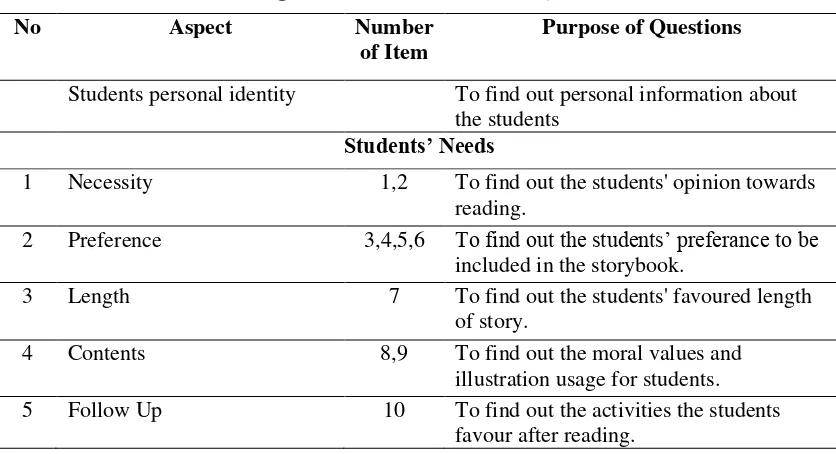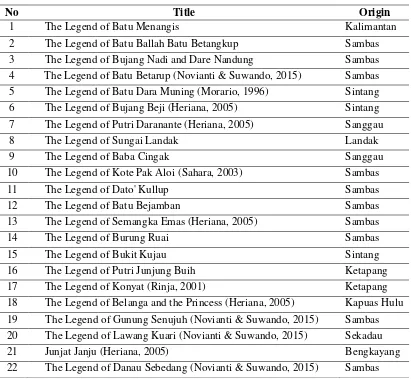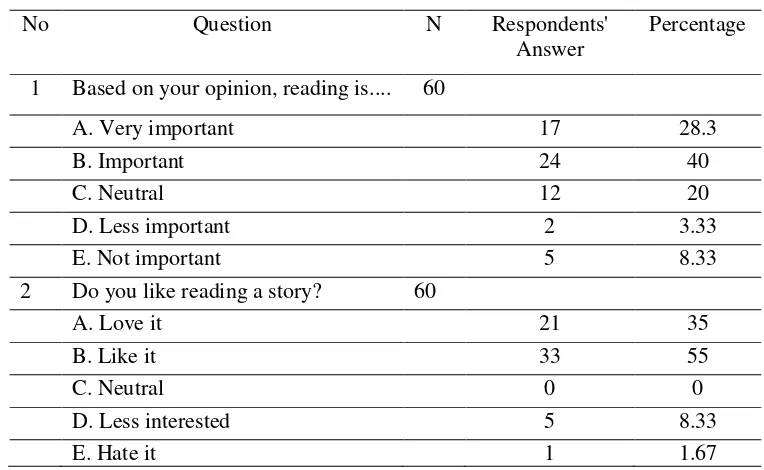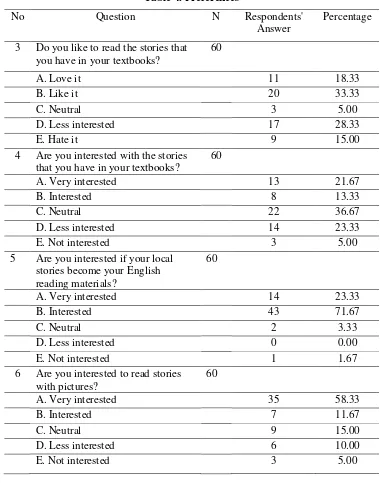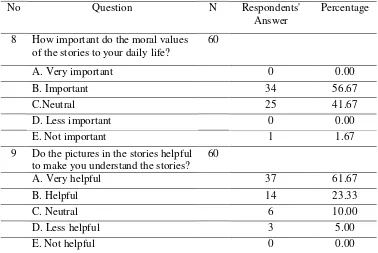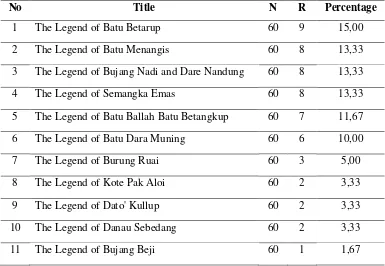2
DEVELOPING A STORYBOOK AS SUPPLEMENTARY MATERIAL
FOR JUNIOR HIGH SCHOOLS STUDENTS BASED ON
KALIMANTAN LEGENDS
Ribud Rinardi, Ikhsanudin Ikhsanudin, Regina Regina
Masters Study Program of English Language Education, Teacher Training and Education Faculty Tanjungpura University Pontianak
Email: [email protected]
Abstract
The main purpose of this research is to develop a storybook for junior high school students based on Kalimantan Legends. The participant of this research were 60 students of junior high school, and an educational expert from Kabupaten Sambas. This research used the platform of design and development research proposed by Richey and Klein. The procedure used is the framework of Jolly and Bolitho, that consist of need analysis, material grid, first draft, evaluation, and final draft. The data of this research has been collected through questionnaires. There were five questionnaires employed in this research. The first questionnaire was given to the students to investigate the need of the students on reading materials based on Kalimantan Legends. The second questionnaire was employed to know the favorite legends of students. From the need analysis result, it can be concluded that students are interested in reading (68.30 %), they like to read stories (90 %). The students are interested to read their local stories (95 %), and they like the stories with adequate illustrations to help them understand the stories completely (70 %). On the other hand, they thought that the stories they have in their textbooks were not interesting (65%). Keywords: Material development, Storybook, Reading, Legends, Need analysis.
INTRODUCTION
Reading is an important skill for students to master. Through a good reading ability, students can read their textbook by themselves without many help from teachers. Graesser in McNamara claims that reading is an extraordinary achievement when we consider how many stages and components that must be mastered to achieve comprehension (McNamara, 2007. p.3). That is why, a good reading ability supports students to do their assignment and examination better than the students who do not have that ability. Unfortunately, this is not an easy thing to make EFL students to master reading skill (Alqarni, 2015.p1). This might happen since reading covers many things to cover to achieve comprehension.
In fact, the condition in the real classrooms in junior high schools are far from ideal. Due to the lack of learning
3 caused by the gap of the learner’s first language and the target language (Rafferty & Bernard, 2012). That is why we need a the students is one of the issues faced by the teachers when they use their workbooks in the classrooms. The text sometimes unfimiliar for the students. Some texts even seem too strange for them. That is the reason why the students hard to comprehend the texts. Furthermore, the workbooks used are not interesting, since they are printed in black and white version. This condition make the reading situation getting worse in the classroom.
Furthermore, in line with the conditions preceded previously, in everyday teaching acticitiy, the teachers must face the fact that the workbooks they use are not enough for achiving the aim for reading purposes. That is why, teachers need supplementary materials. The supplementary materials hopefully can develop students’ reading ability appropriately based on their level and interesting for them. This became important since the main thing in reading is focus on how to motivate the reader to read the provided text (Duffy, 2009.p.3).
Through this research, the researcher tried to develop the appropriate reading materials for the students as the supplementary materials. The material should be appropriate for the students too. Jacobs argues that the appropriate reading materials are important to build the readers’ motivation to read more (Jacobs, 1997). The materials was presented in the style of story book, to make them interested to read the story. A storybook is chosen since storybook reading has been correlated to a variety of reading factors, including children’s
eagerness to read (Allor & McCathren, 2003 cited in Lange & Thompson, 2006).
Many researchers in Tanjungpura University were done their research in the scope of local contents. Zulkarnaen and Novinty (2016) found that the textbook used in junior high schools werep lack of local contents, especially in the case of stories. On the other hand, Puspita (2016) focused on the usage of supplementary materials in the classroom were crucial to make sure that materials the students get were well-prescribed.
RESEARCH METHOD
Conceptual framework of the study
This research used the design and development method. Design and development is a method that focusing on developing a certain product (Sugiyono, 2013.p. 407). This research is conducted to produce a suitable reading materials for students of junior high schools where they have the problem on reading materials availability.
Design, development and evaluation are the holistic process to develop the materials that the writer will use. Furthermore, according to Richey and Klein (2007, p. 8), in design and development research, this research will accomplish these goals through two large categories of research projects: the product with tool and model research. Participants of Research
Educational expert
An expert in education bureau in Sambas Regency was invited as the expert in this research. The expert must also know the characteristics of students in Sambas. The expert must have adequate ability in English, so that he can understand well the developed materials.
Local People
4 the legends the local society have in their community.
Teacher
In this research, a teacher who teach religion in the school was chosen to validate the moral values mentioned in the last part of each legends. This validation was administered to find out the agreement of the moral values in the storybook to the religious and social values in readers’ life.
Students
The sample of this study is the students of junior high schools. There were 60 students of junior high school that involved in the need analysis of this study. They consist of 20 students of grade VII, 20 students of grade VIII, and 20 students represent grade IX.
Research Instruments
The instruments of data collecting in this research were questionnaires. The qustionnaires cover students’ needs, students’ favorite legends, expert’s jugement, contents’ valiity, and moral values validity.
Students’ Needs
The first questionnaire was adaptated from Hutchison and Waters that covered necessity, preference, length, contents, and follow up (Hutchison & Waters, 1991. p. 55-59). The organization of the first questionnaire can be seen in the following table.
Table 1. The Organization of The Need Analysis Questionnaire
No Aspect Number
of Item
Purpose of Questions
Students personal identity To find out personal information about the students
Students’ Needs
1 Necessity 1,2 To find out the students' opinion towards reading.
2 Preference 3,4,5,6 To find out the students’ preferance to be included in the storybook.
3 Length 7 To find out the students' favoured length
of story.
4 Contents 8,9 To find out the moral values and
illustration usage for students. 5 Follow Up 10 To find out the activities the students
favour after reading. Students’ Favorite Kalimantan Legends
The second one is the questionnaire to find out the students’ favorite legends to be
5
Table 2. Students’ Favorite Legends
No Title Origin
1 The Legend of Batu Menangis Kalimantan
2 The Legend of Batu Ballah Batu Betangkup Sambas
3 The Legend of Bujang Nadi and Dare Nandung Sambas
4 The Legend of Batu Betarup (Novianti & Suwando, 2015) Sambas 5 The Legend of Batu Dara Muning (Morario, 1996) Sintang
6 The Legend of Bujang Beji (Heriana, 2005) Sintang
7 The Legend of Putri Daranante (Heriana, 2005) Sanggau
8 The Legend of Sungai Landak Landak
9 The Legend of Baba Cingak Sanggau
10 The Legend of Kote Pak Aloi (Sahara, 2003) Sambas
11 The Legend of Dato' Kullup Sambas
12 The Legend of Batu Bejamban Sambas
13 The Legend of Semangka Emas (Heriana, 2005) Sambas
14 The Legend of Burung Ruai Sambas
15 The Legend of Bukit Kujau Sintang
16 The Legend of Putri Junjung Buih Ketapang
17 The Legend of Konyat (Rinja, 2001) Ketapang
18 The Legend of Belanga and the Princess (Heriana, 2005) Kapuas Hulu 19 The Legend of Gunung Senujuh (Novianti & Suwando, 2015) Sambas 20 The Legend of Lawang Kuari (Novianti & Suwando, 2015) Sekadau
21 Junjat Janju (Heriana, 2005) Bengkayang
22 The Legend of Danau Sebedang (Novianti & Suwando, 2015) Sambas Procedures
This research used David Jolly and Rod Bolitho’s framework (see Figure 1). The writer have applied this framework in developing a storybook based on Kalimantan Legends. Jolly and Bolitho state, “Most materials writers move in this direction, and use some or all of these steps, if not always
6
Figure 1. Proceures in Developing Materials Based on Jolly and Bolitho Framework
RESEARCH FINDINGS AND DISCUSSION
Findings Need Analysis a) Necessities
The necessities part is related to hot important the reading activity is for the
students. In this study, the results of students’ necessities can be drawn as follow.
Table 3. Necessities
No Question N Respondents'
Answer
Percentage
1 Based on your opinion, reading is.... 60
A. Very important 17 28.3
B. Important 24 40
C. Neutral 12 20
D. Less important 2 3.33
E. Not important 5 8.33
2 Do you like reading a story? 60
A. Love it 21 35
B. Like it 33 55
C. Neutral 0 0
D. Less interested 5 8.33
E. Hate it 1 1.67
This table intended know the opinion of the student about reading based on their personal opinion and students interest on reading stories. From table 6 point 1, 40% of the students agreed that reading is important for them. On the other hand, 28.30% students think that reading is very important for them.
From the table above, it can be concluded that the majority of the students (68.30%) agreed that reading is important for them. In table 3 point 2, the intention is to know whether the students like reading or not. From the table 4.1 point 2 above, it can be concluded that 55% of the students thought
Developing Materials Grid
Developing Materials( 1st
Materials Evaluation
Writing Final Draft of Conducting
7 that they like reading a story. The positive respons from the students towards this question is 90%.
b) Preference
Preference refers to what the students want in their reading materials. The
freference focused on the reading materials they wanted to have in their daily life. In this study, the data about preference are presented as follows.
Table 4. Preferences
No Question N Respondents'
Answer
Percentage
3 Do you like to read the stories that you have in your textbooks?
60
A. Love it 11 18.33
B. Like it 20 33.33
C. Neutral 3 5.00
D. Less interested 17 28.33
E. Hate it 9 15.00
4 Are you interested with the stories that you have in your textbooks?
60
A. Very interested 13 21.67
B. Interested 8 13.33
C. Neutral 22 36.67
D. Less interested 14 23.33
E. Not interested 3 5.00
5 Are you interested if your local stories become your English reading materials?
60
A. Very interested 14 23.33
B. Interested 43 71.67
C. Neutral 2 3.33
D. Less interested 0 0.00
E. Not interested 1 1.67
6 Are you interested to read stories with pictures?
60
A. Very interested 35 58.33
B. Interested 7 11.67
C. Neutral 9 15.00
D. Less interested 6 10.00
E. Not interested 3 5.00
c) Length
In this part, the questions wanted to find out the length of the texts that the students
8
Table 5. Length
No Question N Respondents'
Answer
Percentage 7 How long a story should be that you
want to read?
60
A. 1-2 paragraphs 22 36.67
B. 2-3 paragraphs 8 13.33
C. 3-4 paragraphs 23 38.33
D. 4-5 paragraphs 6 10.00
E. 5-6 paragraphs 1 1.67
Table 5 consist of 1 item that focused on the length of the text the participants wanted to read. From table 5, it shows that most of the students wanted a short text to be in their reading materials. Most of students (38.33) thought that the length of the texts they wanted to read is from 3 to 4 paragraphs.
c) Contents
The focus of content part is to find out the desired things should be invloved in the reading text according to the participants’ opinion. This part consisted of 2 items. The data of contents part can be seen in table 9 below
Table 6. Contents
No Question N Respondents'
Answer
Percentage
8 How important do the moral values of the stories to your daily life?
60
A. Very important 0 0.00
B. Important 34 56.67
C.Neutral 25 41.67
D. Less important 0 0.00
E. Not important 1 1.67
9 Do the pictures in the stories helpful to make you understand the stories?
60
A. Very helpful 37 61.67
B. Helpful 14 23.33
C. Neutral 6 10.00
D. Less helpful 3 5.00
E. Not helpful 0 0.00
From table 6 above, the result of contents part can be described as follow. From point 1 in table 6 focused on the importance of moral values of the stories to participants’ daily life. The participants mostly though that moral values they got from the stories they read tend to be
important for their life. It represented by 56.67 % of respondents or 34 of 60 students thought that the moral values from stories they read were important for them.
9 stories. Surprisingly, 85% of participants or 52 of 60 students thought that they would understand easier stories if they are accompanied by pictures as illustrations.
d) Follow Up
This part of the questionnaire wanted to find out the activities after reading the text that the students favoured. The result of follow up section can be drawn as follow. Table 7. Follow Up
No Question N Respondents'
Answer
Percentage
10 Based on your opinion, after you read a story, what is the form of the task you favoured to do?
60
A. Essay questions 3 5.00
B. Retell the stories 1 1.67
C. Multiple choice questions 15 25.00
D. Matching task 17 28.33
E. True and false questions 24 40.00
From table 7 above, the majority of the students thought that true-false questions would be the best activities after their reading (40.00%).
Students Favorite Legends
This part of the questionnaire shows the result of students’ choice on legends title that they chose. The result of this questionnaire had been taken as the title included in the developed storybook.
Table 8. Students’ Favorite Legends
No Title N R Percentage
1 The Legend of Batu Betarup 60 9 15,00
2 The Legend of Batu Menangis 60 8 13,33
3 The Legend of Bujang Nadi and Dare Nandung 60 8 13,33
4 The Legend of Semangka Emas 60 8 13,33
5 The Legend of Batu Ballah Batu Betangkup 60 7 11,67
6 The Legend of Batu Dara Muning 60 6 10,00
7 The Legend of Burung Ruai 60 3 5,00
8 The Legend of Kote Pak Aloi 60 2 3,33
9 The Legend of Dato' Kullup 60 2 3,33
10 The Legend of Danau Sebedang 60 2 3,33
10
12 The Legend of Putri Daranante 60 1 1,67
13 The Legend of Batu Bejamban 60 1 1,67
14 The Legend of Putri Junjung Buih 60 1 1,67
15 The Legend of Belanga and the Princess 60 1 1,67
Table 8 above is focused on the favorite legends the participants wanted to be in the reading materials. The legends were come from many places in West Kalimantan. From the table above, it can be concluded that the title that the participants favoured mostly the legends from Sambas. It is because of the participants taken in this research were the students of junior high schools from Sambas Regency. That is why, the majority of the legends’ title that included in the story book as the product of this research were the legends that originated from Sambas Regency (4 of 6 legends).
Discussion
This research aimed to develop a storybook as supplementary materials for junior high school students based on Kalimantan Legends. Developing a storybook as a supplementary material seems to be important since there were very limited storybooks that provide the stories in English. That is why, it is hard for students to find the material for their reading. That is why, this research proposed as the solution in overcoming this problem.
The storybook developed in this study is in line with the syllabus Kurikulum 2013 for Junior High Schools. In accordance to the materials based on Kalimantan legends.
The need analysis was aministered to 60 students of junior high school in Sambas Regency from grade 7, 8, and 9. The result of need analysis can be drawn as follow. The
students of junior high schools are interested in reading. That is why, the majority of the students answered positively through this question (68.30 %). Furthernore, the students also like to read stories. It can be shown that almost all of the students answered positively towards this question (90 %). On the other hand, the students are interested to read their local stories (95 %). That is the reason why the stories that included in the storybook were derived from their local stories. The students also like the stories with adequate illustrations to help them understand the stories completely (70 %). That is why, the developed storybook contains many illustrations to boost students understanding towards the stories. On the other hand, they thought that the stories they have in their textbooks were not interesting (65 %).
11 were given 22 titles of legends from Kalimantan and they had to choose once per student. From the result, the title for unit 1 is The Legend of Batu Menangis (13.33%), unit 2 is The Legend of Batu Ballah Batu Betangkup (11.67%), unit 3 is The Legend of Batu Betarup (15%), unit 4 is The Legend of Bujang Nadi and Dare Nandung (13.33%), unit 5 is The Legend of Semangka Emas (13.33%), and unit 6 is The Legend of Batu Dara Muning (10%).
From the result of the second questionnaire where the students asked about their favorite legends, the majority of the students chose their favorite legends based on how familiar the legends were to them. That is why, the result of the questionnaire shows that the majority of the legends chosen by the students were the legends from Sambas Regency, where the legends were usually told by elders to them.
The organization of the text in the storybook was also in line with grading concept, where simpler texts come first. That is why, the text in 1 is less complicated than the text in unit 6. The researcher believed that reading a shorter and simpler story at the beginning can promote readers spirit to read the next stories in the upcoming units.
Then, each unit consist of introduction, reading text, vocabulary review, and moral values corner. Every unit in the storybook has the same genre of text, and also has the same material design as previously presented in this study. Introduction parts of the storybook consist of a picture to represent the whole story in the unit, an information box that provide the information about the origin of the legends; let’s read section where the main reading text is written. Reading texts including many pictures as the means to help the readers understand the story easily. Vocabulary reviews are the list of 10 words to remember by the readers. This part of the storybook leads the reader to remember the new words used in the texts. The moral value section is the place where the messages from the stories were elicited and listed. This is to simplify the readers to learn for their life in real society.
CONCLUSIONS AND SUGGESTIONS Conclusion
According to the result of needs analysis questionnaire that distributed previously, it can be concluded that the needs of junior high students on reading materials based on Kalimantan Legends can be listed as follows: (1) the students like to read stories; (2) the majority of the students that they did not totally interested to the stories presented in their existing textbooks; (3) the majority of the students thought that the local stories as their reading materials would be interesting; (4) most of students were interested to read stories with pictures and illustrations; and (5) the students thought that moral values they got from stories were important to them in their daily life.
Suggestions
12 REFERENCE
Alqarni, Fawaz. (2015). Collaborative Strategic Reading to Enhance Learners Reading Comprehnsion in English as A Foreign Language.Academic Journal of
Interdiciplinary Studies. pp 1.
Dodd., et. al. (2015). The Use of Supplementary Materials in English Foreign Language Classes in Ecuadorian Secondary Schools. English Language
Teaching. pp 188.
Duffy, Gerard. G. (2009). Explaining Reading: A Source for Teaching,
Concepts, Skills, and Strategies.New
York: The Guilford Press.
Hatchison, T. & Waters, A. (1991). English
For Specific Purposes. Cambridge:
Cambridge University Press.
Heriana, S. S. (2005). Dayang Putih.
Pontianak: Romeo Grafika.
--- (2005). Bujang Beji. Pontianak: Romeo Grafika.
--- (2005). Junjat Janju. Pontianak: Romeo Grafika.
Jacobs, G. M. et. al. (1997). Successful
Strategies for Extensive Reading.
Singapore: Seameo.
Lange, S.M. & Thompson, B. (2006). Early Identification and Intervention for Children at Risk for Learning Disability.
Journal of Special Education. pp 104.
McNamara, Danielle S. (2007). Reading Comprehension Strategies - Theories,
Interventions, and Technologies. New
Jersey: Lawrence Erlbaum Associates, Inc., Publishers.
Morario. (1996). Keluarga Pak Aloi dan
Dara Muning. Pontianak: Balai Kajian
Sejarah dan Nilai Tradisional.
Novianti, E. & Suwando. (2015). Lawang
Kuari: Antologi Cerita Rakyat
Kalimantan Barat. Pontianak: Balai
Bahasa Provinsi Kalimantan Barat. Rafferty, E., & Bernard, E. (2012).
Improving Reading Proviciency via Interactive Online. Electronic Journal of
Foreign Language Teaching, pp 368.
Richey, Rita C. & Klein, D. James. (2007).
Design and Development Research.New
Jersey: Lawrence Erlbaum Associates, Inc.
Rinja,S.(2001). Konyat The Smart Hero.
Pontianak: Romeo Grafika.
Shen, M.-Y., & Huang, Y.-K. (2007). Collaborative Action Research for Reading Strategy Instruction: A Case in Taiwan. Electronic Journal for Foreign
Language Teaching, pp 108.
Sugiyono. (2013). Metode Penelitian
Pendidikan Pendekatan Kualitatif,
Kuantitatif, dan R&D. Bandung:
Alfabeta
Tomlinson, B. (2011). Materials
Develop-ment in Language Teaching. Cambridge:
